... better known as Dr. Delicious and The Boss...

... but first a quasi-negative panorama of the landscape at Kikelewa Camp, our stop after Day 7 of the trip, and Day 3 of the ascent. It was starting on this day that we permanently entered an Africa landscape that was completely different from anything else any of us had ever experienced in our lives. Breathtaking.
Sorry for not posting last week folks. 4th of July and the aftermath kind of scrunched my schedule. But I'm back!
And in our fanmail, Neal gave a guess for my question from last week that it was William who overcame all olfactory obstacles to have a healthy appetite throughout our trip. Survey says... negatory. In fact, William's appetite shrunk the most (combination of altitude and smell), while I continued my trash compactor ways, and Resha muddled somewhere in the middle.
Back to our regularly scheduled program.
After stuff about altitude sickness and bathrooms, the third most asked questions had to do with food.
- What did you eat?
- When did you eat?
- How many meals did you eat?
- Did you get enough to eat?
- Was it palpable?
- Was it good?
- Where did you eat?
- Who cooked your food?
I'll start with the last question first.
Our personal chefs were Hans and Goodluck on the safari and trek, respectively, aptly named Dr. Delicious and The Boss. Hans was a friend of David's since childhood, and he earned the nickname around Maasai Wanderings for being the best chef they had; or so we were told by Erica, the owner of Ahadi Lodge. Having eaten lots of Hans' culinary creations first hand, however, I can't say I disagree.
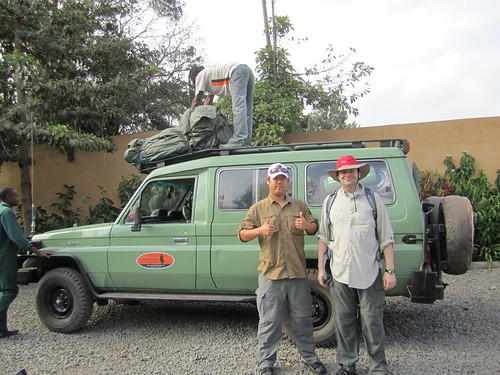
That's Hans on top of our Land Rover. You would think that with over 1,800 photos, there would be a better picture of Hans, but you would be mistaken. Huge omission on our part. We actually were never in the car that often with Hans, as David would usually drop him off at the campsite to prepare the day's meals, while we went off to sightsee. And at the beginning of the trip when we were exhausted, David and Hans just bantered back and forth in Swahili as you would expect two best friends to do. It wasn't until the way back that we got into some good discussions with Hans. Two in particular stick out in my mind.
The first had to do with the Swahili words our Arushan cab driver had taught us on the way to the airport. He confirmed the accuracy of most of them, but when we said salaama for an alternative "hello" instead of jambo, he kind of got a puzzled look on his face. After some deep contemplation, however, a lightbulb went off in his head and he smiled and said "ah, salaama. You must have spoken to a muslim," which in hindsight makes sense, since salaam means "peace" in Arabic, so salaama is the equivalent of saying "peace be with you." And there you go.
The second had to do with vacations (holiday). Specifically, we said we were in Tanzania on vacation (holiday), and he explained that our concept of vacation was foreign to most Tanzanians for several reasons. First off, most of the Tanzanian population is very poor, so taking days off means a day of lost income, not a luxury many people can afford. Relatedly, when people do go on vacation for, say religious or national holidays (or college students on break), they just go to their hometown and celebrate with their families. And that pretty much defines their lives: work and going home to family. This is why Hans has never left Northern Tanzania, and the farthest David had traveled was Nairobi, just across the border in Kenya. Hans said he heard that black South Africans were starting to amass enough wealth collectively to take vacations (holiday), but that was about it.
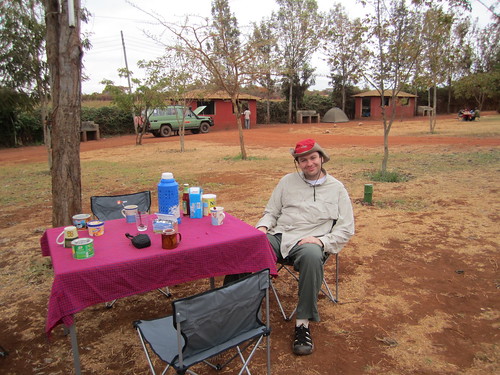
Hans cooked our hot meals in the designated cooking areas. Sometimes the cooking areas were for one cook, like the red brick buildings behind William in the above photo...
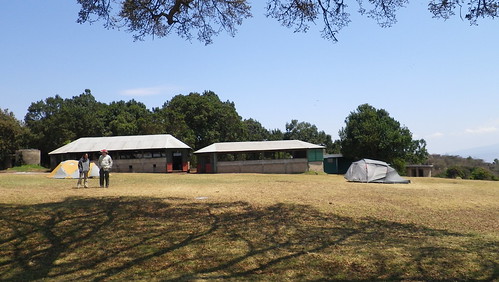
... and sometimes the cooking areas were for lots of cooks, like the building on the left directly behind Resha and William. I think he preferred the group cooking, as I happened to walk by in the middle of night while going to the bathroom, and the cooks sounded like they were having a grand old time, yelling back and forth at each other while the prepared meals for the next day. Hans later said they were up until about 4AM, and why not? They don't go on the safaris, so they mostly sleep during the day anyways.
Two interesting things on the way Hans cooked. (1) He cooked everything over a wood fire. He said it tasted better that way. (2) He didn't use any cooking utensils other than a knife. This especially came to light when he asked how he made his delicious soup, and he said it was a simple recipe of vegetables, water, milk, and spices. This would not be remarkable, except that while we clearly tasted vegetables, we could not find any vegetables in the soup. He said that he prepared the vegetables small enough that they just dissolved in the soup. And when we asked if he had used some sort of grater, he said "no, I just used my knife. It tastes fresher that way." Shocked, we asked how long that took, and he said "a couple of hours." Daaaaaaaammmmmmmnnnn. Now THAT's service.

Our cook on Kilimanjaro, on the other hand, was Goodluck (the guy in the middle dressed in pink). If Ronald was our GWBush, Goodluck was our Cheney, in a non-Darth Vader sort of way. While Ronald's primary responsibility was as the figureheaded front man who provided us with the big picture (showing us what path to go down, explain things to us, and make sure we knew what was going on), Goodluck's job was to make sure that the ships ran on time. He had to oversee a crew of twelve (everyone except the guides), and he did it in ridiculously competent fashion.
You immediately knew Goodluck was extremely bright as soon as you met him. Very cheerful most of the time (more on that later), there was just a sparkle in his smile and eye that made you immediately comfortable. Because Goodluck was so busy all of the time, and his English was just okay, we didn't get to chat with him too much. We chatted a little bit with him on our ride from Arusha to the mountain, where he jumped out to his parent's house on our way up to Marangu gate to pack, and a bit at Kikelawa camp when we had a short hike, and so had some downtime.
Our longest conversation with him was actually had by Resha. While we had been eating in the tent, he was busily chatting on his mobile phone in rapid Swahili while cooking meals for the crew. When he hung up, Resha asked who he had been talking to. It turned out he had a girlfriend, and so he said he was just checking in with her. When Resha asked what his girlfriend thought of him trekking up the mountain for a week away from her, he said something along the lines of "she understands it's for work so I can buy her pretty things," threw his head back, and laughed. We tried to engage him longer, but our vocabulary got too foreign for him very quickly, and when we saw the polite smile and nod with glazed over eyes, we knew we had lost him. Too bad, because I think he had a lot of fascinating things to say.
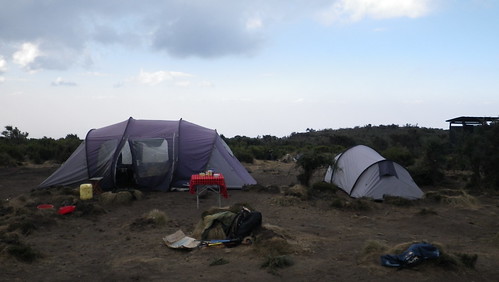
Now, unlike the safari, the mountain was very much BYO-everything, including cooking areas. The ugly purple tent on left served as that cooking area... and dining area (when it was cold)... and storage area... and sleeping area for some of the porters. About 20 feet in length and ten feet wide, we spent a lot of time in that tent and got to know it very, very well.
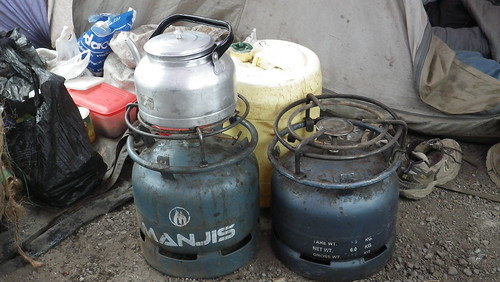
Everything was cooked on what-I-assume-were-propane hybrid stoves/tanks that looked like these. Just over a foot in diameter, to say they were heavy was an understatement. On top is, of course, a water pot which was used to boil or drinking and washing water.

The pots, kettles, utensils, tanks, and all other cooking implements were carried in straw baskets that looked like these. Over the course of the trip, we found that there was some informal competition among porters to not carry the heaviest things, which was a tie between the tanks and the water canteens. Now, you would think it was a no-brainer that the water canteens would be lighter, especially since you could fill it up with water at most campsites, however, we quickly found out on the day after that this was NOT the case.
Okay. That's the basics of eating for now. The actual food and meals will be in next week's post.
Each day on the ascent, because the actual trek up was relatively short (we would begin around 9AM and be done by lunchtime), in the afternoon we would go for about a two hour acclimatization walk. The purpose of this was several-fold. First, it was to get us in shape for the final ascent, where we would be climbing for almost 10 straight hours. Second, it helps if you sleep below your highest point of the day. So, by gaining some altitude in the afternoon and then coming back down in the evening, hopefully it lessens any altitude effects. And third, there were very cool things to see all around the camps, as because our ascent was so rapid, we were pretty much in a different climate zone every day.
(Photo courtesy of geocaching.com)
What we carried didn't vary much from our regular treks (maybe less clothes - but we were only carrying water and snacks mostly), but or guides didn't carry anything. While Ronald and Jonas would guide us when we went camp-to-camp, on these afternoon treks, it was usually Jonas and Modi who took us. I guess we was a waiter/guide-in-training.


As you can see, by now the sun had caused the moisture in the soil to rise, and so there were lots of clouds and mist on our afternoon walks...




... which caused some awesome sunbeams to cut through the cloud breaks, giving an almost religious beauty to the landscape.


That's Kibo and Uhuru Peak hiding behind those clouds. She is getting ridiculously close.



Resha's and William's response to these landscapes was very normal... or at least "normal" in the sense that they acted pretty as they did the whole trip.


I, however, decided to go to the blasphemous Jeebus-impression route. Would have been a shame to make such amazing sunrays (and landscape) go to waste.

Okay, back to my normal poses.


And as we walked back to camp, and night began to fall, the falling temperatures crystallized all the water vapors, and Kibo emerged.


The highlight of our day, however, was when we finally entered the damp moorland, which looked like another planet... certainly a landscape that I had never seen before.

We were greeted by the first of these dendrosenecio trees. They are remarkable in that they grow in height when their leaves die and form parts of the trunk. You can see in the beginning of this process at the bottom.


We ain't in Kansas no more.

It was at this point I couldn't resist breaking out Barack, even if Resha (and everyone else) thinks I am crazy...

... which, given that I am jumping over this stream with Barack, I guess would be a fair assessment.

But at least I wasn't alone. Craziness loves company. Until next week...
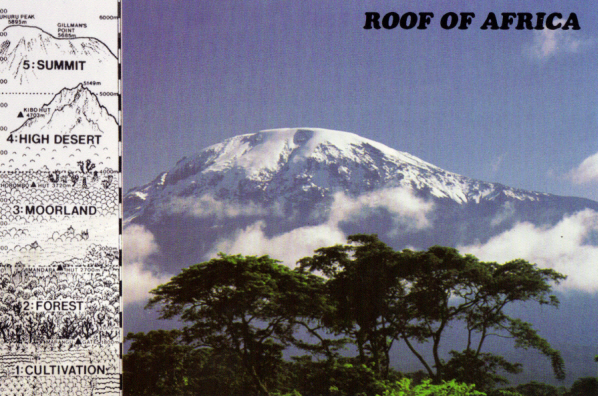
No comments:
Post a Comment